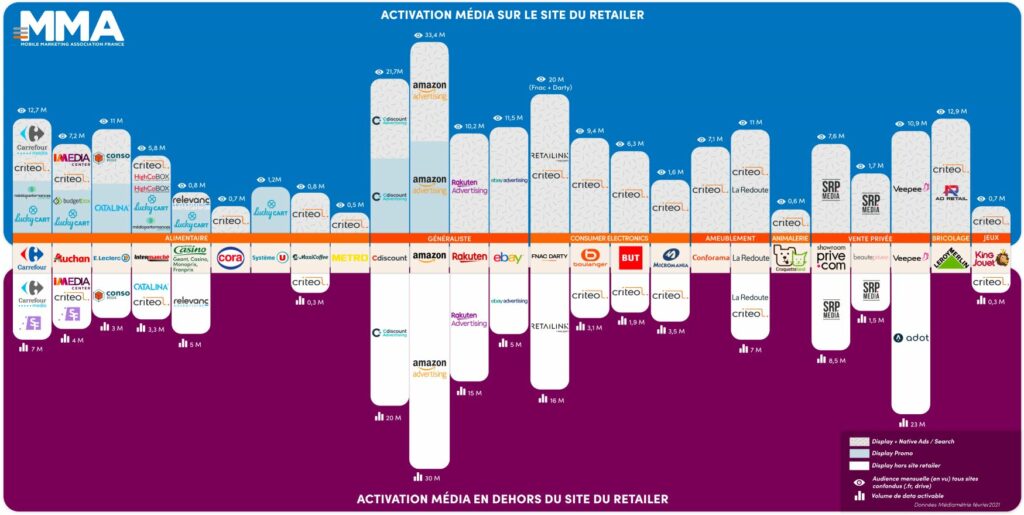
Retailers looking for alternative revenue streams and brands seeking to develop their visibility throughout the consumer’s purchasing journey, especially online, increasingly turn to retail media to meet their goals.
Amazon, who spearheaded this trend, has been taking advantage of its massive audience over the past several years: the online platform has been offering a paid service to advertisers to increase their visibility on the website, thereby guaranteeing increased sales and ROI.
Traditional brick and mortar retailers are following suit, in all sectors including food, electronics, hardware and toys.
But where does retail media stand today? What are some of the strategies used by retailers?
In this article you will find an overview of retail media in France, in the food and specialised retail industries, and key features to keep in mind when implementing a strategy:
– to meet the retailer’s monetising goals
– to let brands emerge throughout the customer pathway
2020 : RETAIL MEDIA CONTINUES TO GROW
Retail media is increasingly becoming omnichannel
As you have most likely noticed, the digital transformation of retail was a lot faster in 2020. Consumers are omnichannel at their core, and use both e-commerce and brick and mortar retail for their purchases.
In July 2020, 55% of French consumers stated they purchased food items both online and in stores (Criteo Retail Media study).
We have also seen a strong surge in the ROPO effect (Research Online Purchase Offline). Taking for example FNAC in France [article in French
], 49% of customers first look up information online before purchasing an item in store (only 4% of buyers do the opposite, called showrooming).
Consumer journeys are increasingly more complicated today, so retailers and brands alike must learn to broadcast their messages on all the channels their targets use, in a coherent and unified manner.
Some retail chains are beginning to offer a multi-channel retail media system. This is the strategy adopted by RetaiLink, FNAC-Darty’s in-house media agency, through which it offers advertisers the opportunity to promote their products using different channels and formats [article in French
]: digital (search or display), in store display, social media campaigns and/or branded content, custom event planning…

Digitising in-store advertising spaces makes implementing an omnichannel retail media offering easier, and lets brands communicate the same message throughout the customer’s journey.
Arnauld de Saint Pastou, head of RetaiLink, explains how the brick-and-mortar store’s purpose goes beyond shopping: “Our stores have become crossroads for audiences […] brick-and-mortar locations have therefore become a channel, a crossroad where consumers can connect and experience the products”.
But how to unify your communication strategy across different formats? Through data obviously. With past purchases stored on loyalty cards, retailers collect a lot of information on their customers. This data in turn lets advertisers send the right message to the right target, and later analyse the results.
POS, demo or tasting stands, flyers, etc., brands already use in-store retail media to emerge along the consumer’s pathway. As retail media tools get digitised, brands can now go further in customising their messages and improve their interactions with consumers. But are they ready to invest in these new advertising formats?
Brands are increasing their e-retail media investments
In terms of e-retail media usage, advertisers have not all reached the same level of maturity: in 2019, according to the Publicis and Criteo e-retail media indicator, 98% of respondents had invested in e-retail media, but only 19% of companies allocated over 15% of their spending to e-retail media.
It should be noted that the electronics devices industry is the most advanced in this area: a third of manufacturers have invested over 15% of their budget.
Regardless of these differences, there is a general increase in company usage of e-retail media. In 2019, 77% of them had increased their investment from the previous year, and over 80% planned on increasing their budget for 2020.
They stated the following as their 3 key goals:
- Increase online sales
- Create a new point of contact with the consumer
- Increase brand awareness
2020 and the Covid-19 crisis showed us the importance of investing in digital retail media. With the drop of attendance in superstores and the increased use of e-commerce (+2.5 million according to Kantar), digital retail media is an efficient way of staying in touch with key target audiences and to be visible.
Additionally, it is very likely that these new customers will continue using e-commerce platforms in the long run. It’s actually what Laurent Kircher, Senior e-commerce manager at Unilever, shared with us about the click and collect channel: “We expect that about 30% of the new users of click and collect will keep using it in the future. It’s absolutely huge, this propels us two years ahead”.
Everything points towards brands increasing their digital retail media budget to activate their consumers where they currently are: on digital pathways.
The only hurdle is having retailers offer advertising opportunities on the relevant pathways so advertisers can use them.
2020 : RETAIL MEDIA STRATEGIES AMONG RETAILERS
Retailers are diversifying their e-retail tools
Sensing the trend getting stronger, retailers are increasingly including retail media in their relationships to their suppliers, either directly through commercial agreements, or through their overall commercial relationship.
And retailers know they have to go all in to make their retail media attractive to advertisers, so they are developing different formats, especially digital.
On the one hand, on e-commerce websites:
- Display is booming, with a 31% increase in investments in 2019 (Obs e-pub SRI-Udecam). Brands use it to display banners on retailers’ e-commerce websites, or directly in the different food categories.
- Product recommendation on the customer journey. It is becoming very popular, as it meets the consumer’s need for a personalised experience while boosting the average basket value. It can be coupled with a price discount.
- The search feature is still on the rise, as it is continuing its 2019 trajectory with a 39% increase of investments (Obs e-pub SRI-Udecam). This tool lets brands display their products in the retailer’s search engine.
- Retargeting, through which brands address a message on a third-party website to target audiences who have already browsed the retailer’s website, is also gaining traction.
On the other hand, retailers are continuing to implement new e-retail media formats in their stores, like for example:
- Retailers’ mobile apps, which ease the purchasing experience (scanning products, payment through the app) and promote relevant offers to the consumer, like for example E.Leclerc and the Heyo app, and Casino with Casino Max.
- Electronic tags, which draw attention to the product and increase brand awareness. They are available at 4 Casino, a fully digitised store, spearheading innovative communication and purchasing processes in France.
- DOOH (Digital Out Of Home) screens are also gaining traction in stores. They harness both the advantages of a digital display (giving context, allowing for interactions and responsiveness) and the power of display (a mass media).
Aware of the benefits of this advertising format for advertisers, and capitalising on a massive in-store audience (over 260 million shoppers per year), RetaiLink, the advertising agency of FNAC-Darty, decided to add 2,000 additional screens in its retail locations [article in French
], on the shopper journey, in windows, and on the stores’ outside walls.
Various strategies among retailers: in-house project development or outsourcing?
Retailers looking to integrate their retail media offer throughout several purchasing pathways to bring value to the brands either develop projects in-house or call upon outside service providers.
The French Mobile Marketing Association summarised this perfectly in an interesting map looking at retail media activities [in French] among large retail chains.

This is what the following retailers chose:
- Amazon, owner of Amazon Advertising, which offers all e-retail media formats on its website and third-party websites. Since its launch in 2013, the famous e-retailer’s retail media offer has changed dramatically. Today it is a complete e-retail media toolbox, which includes display banners, search features, as well as sponsored products on the website’s search engine or promotional offers.
- Rakuten, and Rakuten Advertising, is following in the footsteps of the GAFA internet giants. Most notably, brands can broadcast their message directly on the Rakuten website, but also on the group’s On Demand video platform, and via its direct messaging channel, Viber, using several available formats.
- Cdiscount, and RelevanC, which chose the same setup, and offer display and search options.
- Showroom Privé, and SRP Media, which focus on display and promotional activation.
- Ebay Advertising which, in addition to offering the traditional display and native ads, has set up clever retail media packages on its website, like for example the “Checkout Success Page”, used to display ads directly on the e-commerce cart page.
Other retailers have decided to outsource their retail media offer to third party service providers. This stems from a decision not to invest internally, or from a lack of expertise in the area. These players choose to rely on outside solutions tailored to their specific needs.
Here are some of the retailers who chose this option:
- Micromania, and its on-site off-site display, native ads, search, and pathway activation offers
- Conforama and King Jouet, who have similar strategies: an extremely broad retail media offering including display, native ads, search, and activation
- Boulanger, which focuses on native ads on its website, and display ads on other websites
- Leroy Merlin, which only offers classic and promotional display on its e-commerce website
Lastly, several specialised retailers and grocery store chains choose a hybrid model, managed partly internally and partly with the help of third-party service providers. This is the case of:
- Grocery stores like Carrefour, Auchan retail, or E.Leclerc
- And other specialised retailers like FNAC-Darty or La Redoute.
This should give you plenty of material to create the right strategy for your company, and chose a model that fits your goals.
3 KEY ELEMENTS TO KEEP IN MIND
#1 Consumers are becoming increasingly more omnichannel, especially with the boom of online shopping stemming from the Covid-19 crisis. This creates a de facto rise of retail media across all sectors.
You must let advertisers broadcast messages across all pathways in a unified way: in-store and online.
#2 Brands already use retail media at their brick-and-mortar points of sale, and are starting to invest more in digital formats.
Develop your retail media offer to attract advertisers and foster investment in your solutions.
#3 On the retailer side, some develop their own advertising branch, to monetise their e-commerce channel, while others choose to outsource and call upon a specialised service provider, and some do a mix of both.
Choose the right model for you based on your financial and workforce resources.
